Channel Associated Signaling Analyzer
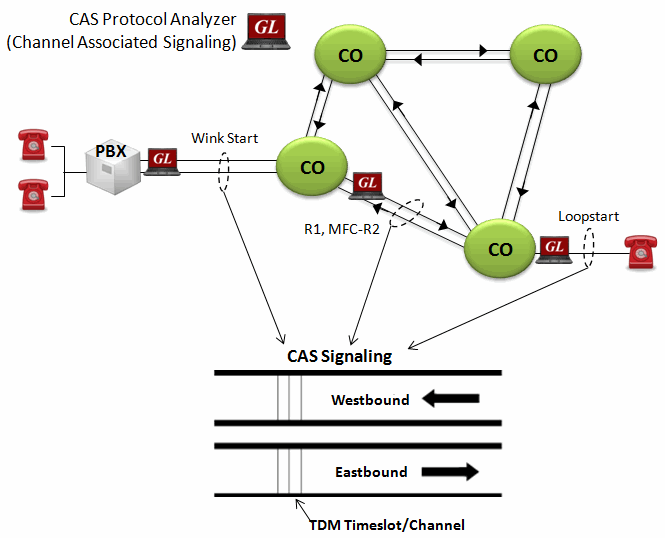
Overview
Channel Associated Signaling (CAS) is a method of signaling in telephone networks where each channel or timeslot carrying speech also carries with it the signaling and addressing to set up and tear down that same channel. This is commonly referred to as 'in-band' signaling as opposed to 'out-of-band' signaling, such as ISDN or SS7. Signaling bits associated with each voice channel carry 'on-hook' and 'off-hook' status and addressing information in the form of dual tone digits to direct the call to its destination.
GL's CAS Analyzer supports real-time monitoring and decoding of CAS signaling events over T1 E1 networks. Supported standards include MFCR2 and R1 protocols. The Real-time CAS Analyzer works with GL's T1 E1 analyzer hardware and corresponding software licenses (XX600, XX610, XX620, XX630).
Channel Associated Signaling (CAS) simulator is an optional application that works along with the GL's T1 E1 Analyzer Cards and Windows Client/Server software that simulates and analyzes any user-defined CAS protocols.
CAS analyzer collects physical and line level status and performance information, voice, data, protocol, statistics, and transmit information to a central / distributed Network Management System (NMS).
These probes now supports Packet Data Analyzer with recording capabilities. Packet Data Analysis (PDA) is an outstanding tool for live monitoring of signaling and traffic over TDM. Allowing users to monitor live TDM networks including capture, analysis, and reporting of every call-in detail.
GL’s NetSurveyorWeb™ (PKV170) a central system comprised of a database engine and web server monitoring systems facilitate real-time analysis, historical storage, retrieval, querying, and display of Call Detail Records (CDRs) by non-intrusively connecting to TDM, Optical, or IP networks.
It also offers NetSurveyorWeb™ Lite (PKV169) a cost effective, simple Plug & Play connection, which is an integrated and simplified web-based system that is distributed at probe level.
CAS emulation is also available with GL's Message Automation and Protocol Simulation (MAPS™). MAPS™ is a multi-protocol, multi-technology platform used for the emulation of a variety of communication protocols over IP, TDM, and Wireless networks. MAPS™ CAS can automate the testing procedure allowing the users to establish calls, and send/receive TDM traffic such as DTMF/MF digits, Tones, Voice, and Fax. In addition, GL supports various E1 MFCR2 analysis and simulationsolutions.
Main Features
- Displays summary, detail, hex-dump, and statistics views.
- Summary View displays captured timeslot, sub channel, frame#, device#, CAS signaling information like signaling bits, digits, type of digit, tone, frequency of tone, power of tone, on duration and off duration etc.
- Detailed View displays decodes of a user-selected frames from the summary view.
- Statistics View displays statistics based on frame count, byte count, frames/sec, bytes/sec etc for the entire captured data.
- Hex dump View displays the frame information in HEX and ASCII format.
- Streams may be captured on the selected time slots (contiguous or non-contiguous) and on full bandwidth.
- Supports filtering and search based on digits, type of digits, signals etc.
- Exports Summary View information to a comma delimited file for subsequent import into a database or spreadsheet.
- Capability to export detailed decode information to an ASCII file.
- Status bar displaying information regarding running percent utilization, number of frames captured, CRC errors and frame errors etc.
- Any protocol field can be added to the summary view, filtering, and search features providing users more flexibility to monitor required protocol fields.
- Option to create multiple aggregate column groups and prioritize the groups as per the requirement to display the summary results efficiently
- Allows the user to create search/filter criteria automatically from the current screen selection
Packet Data Analyzer (PDA) features:
- Provides options to capture voice, digits, tones or FAX traffic.
- Segregates, captures, and collects statistics on TDM calls.
- Provides graphical representation of call analysis, such as ladder diagrams of protocols
Supported Protocol
The supported protocol standards in CAS protocol analyzer is MFCR2 and R1.
- CAS-MFCR2
- CAS-R1
Summary, Detail and Hex dump View
The protocol analyzer opens with Summary, Detail and Hex Dump as default panes. Statistics and Call Detail are optional panes, which can be viewed if required.
- The summary view displays port number, frame, length, event type, signal type, tones, digits, and more.
- User can select a frame in summary View to analyze and decode in the detail view.
- The Hex dump view displays the frame information in HEX and ASCII format. The contents of detail and hex dump view can also be copied to clipboard.
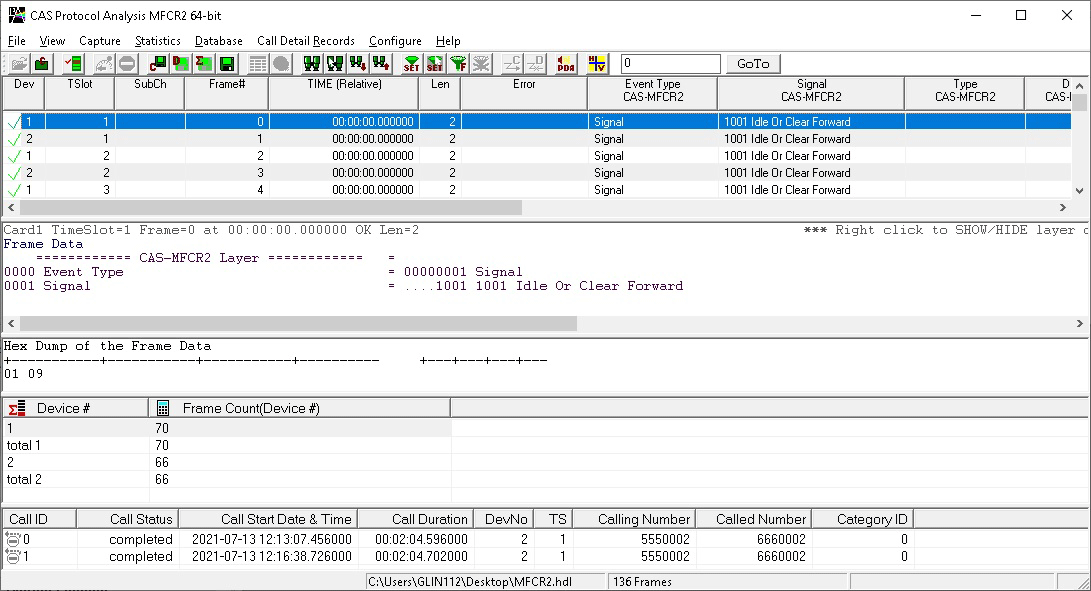
Real-time and Offline Analysis
Users can capture and analyze frames in real-time and record all or filtered traffic into a trace file. The recorded trace file can then be analyzed offline and exported to ASCII file, or printed.
The real-time analysis is used to capture data on one or multiple T1 E1 lines on the specified timeslots simultaneously during transmission. The captured data is always stored in a temporary file.
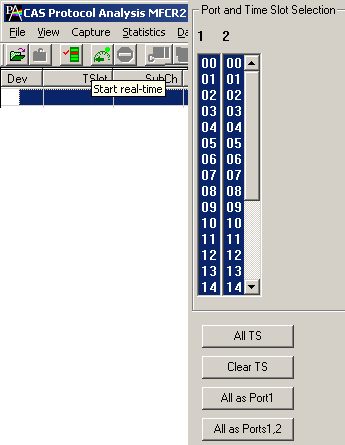
Filtering and Search
User can record all or filtered traffic into a trace file and can create search/filter criteria automatically from the current screen selection. The filter and search options add a powerful dimension to the CAS analyzer that isolates required frames from the captured frames in real-time/remote/offline. These features isolate required frames from all the captured frames in real-time.
Users can specify custom values for frame length to filter frames during real-time capture. The frames can also be filtered after completion of capture based on various protocol parameters such as CAS signaling type, digits, tones, or erred frames.
Similarly, search capability helps user to search for a particular frame based on specific search criteria.
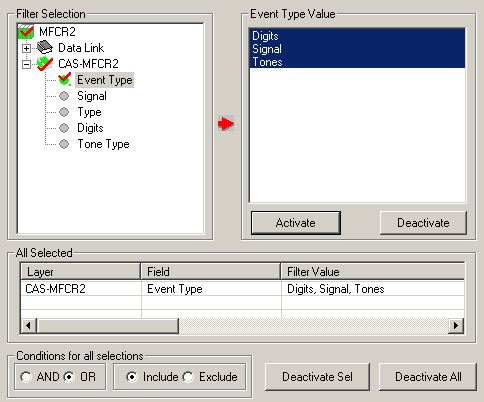
Aggregate Column Group
The enhanced feature of the protocol analyzer is aggregate column groups. The user can also create multiple aggregate column groups and prioritize the groups as per the requirement to display the summary results in an efficient way.
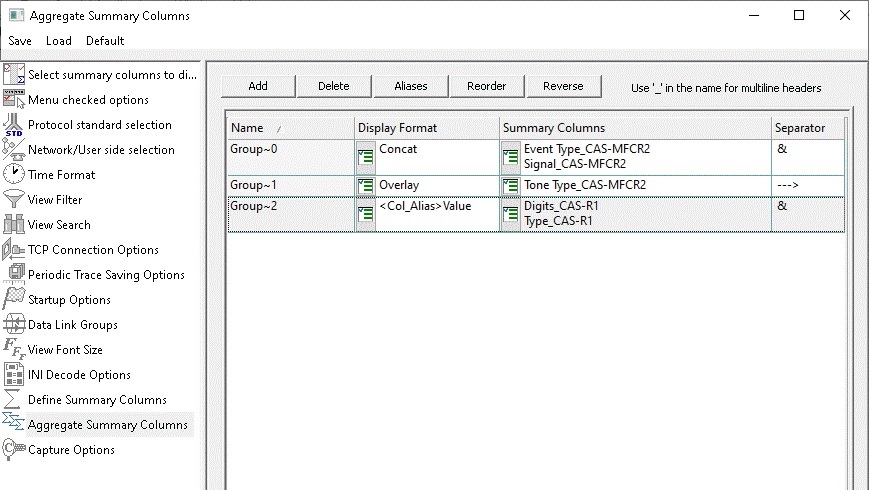
Aggregate Summary Column Group
The updated results are as shown below. Here the root aggregate group~0 summary columns are displayed first and then Group~1 and Group~2 as per the assigned priority.
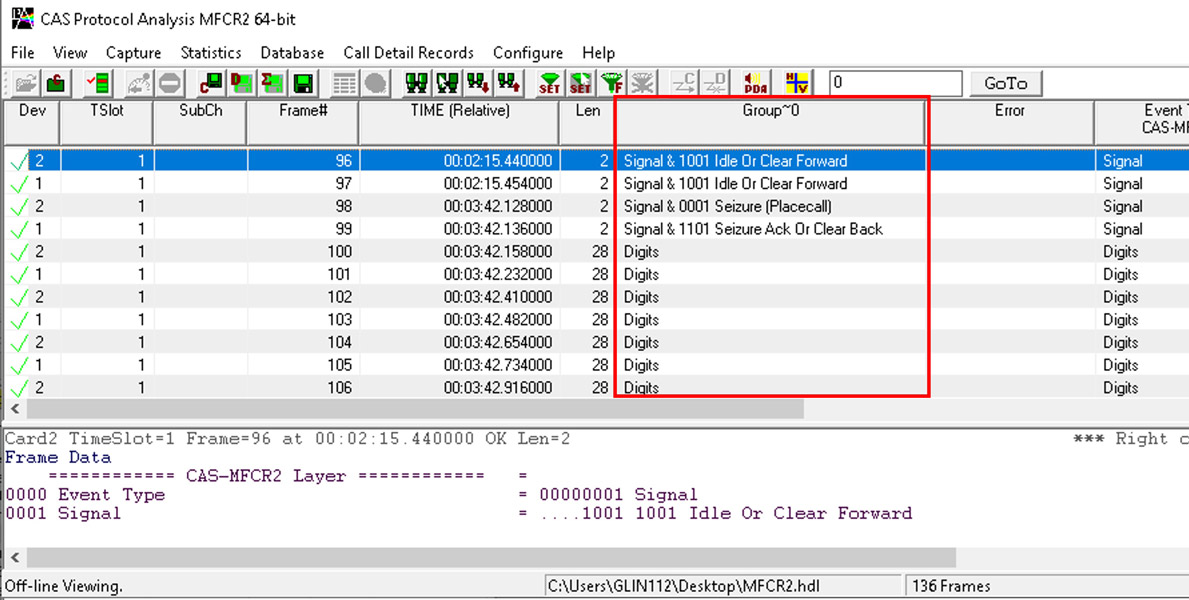
Display of Aggregate Column Group in Summary View
Call Detail Record View
Important call specific parameters like Call ID details, the calling status whether the call is active or completed, calling number, called number, call start date and time, call duration, release cause, device number, and so on are calculated and displayed in Call Detail View. Additionally, users are provided with the option to search a particular call detail record from the captured traces.
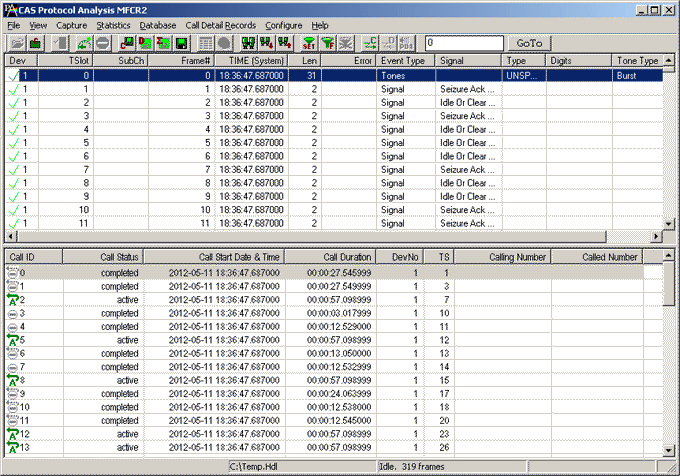
Statistics View
Various statistics can be obtained to study the performance and trend in the CAS analyzer based on protocol fields and parameters
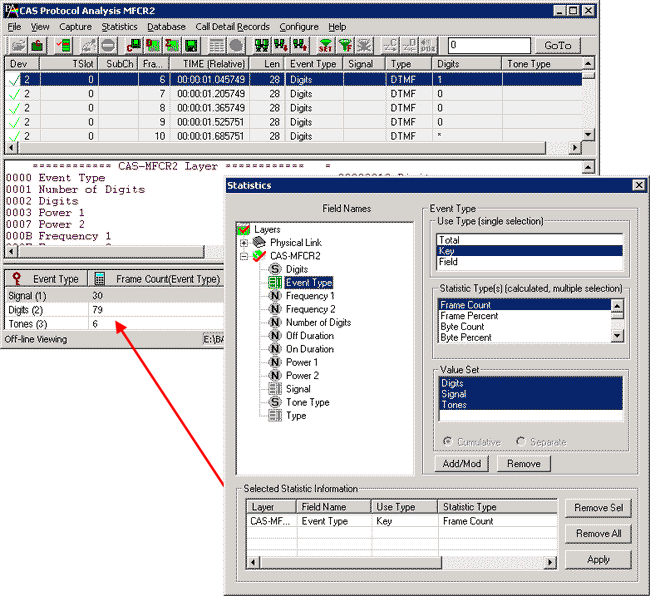
Save / Load All Configuration Settings
Protocol Configuration window provides a consolidated interface for all the important settings required in the analyzer. This includes various options such as protocol selection, startup options, stream/interface selection, filter/search criteria and so on. All the configuration settings can be saved to a file and then loaded for future operations, or user may just revert to the default values using the default option.
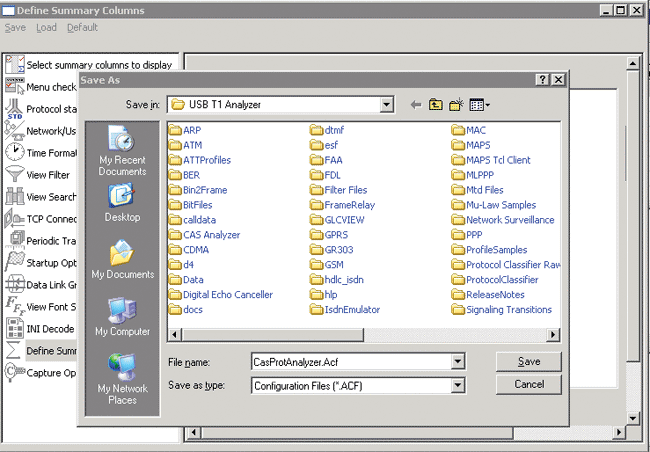
Resources
Note: PCs which include GL hardware/software require Intel or AMD processors for compliance.
Please Note1: The XX in the Item No. refers to the hardware platform, listed at the bottom of the Buyer's Guide, which the software will be running on. Therefore, XX can either be ETA or EEA (Octal/Quad Boards), PTA or PEA (tProbe Units), depending upon the hardware.
| Item No. | Item Description |
| XX092 | T1 E1 Channel Associated Signaling (CAS) Analyzer |
| XX093 | Call Capture Option for CAS Protocol with PDA |
| Related Software | |
|---|---|
| XX651 | MAPS™ CAS Protocol Emulator |
XX625 |
CAS Simulator |
XX610 |
|
XX620 |
w/ DTMF/MF/MFC-R2 + answer/place call capability |
XX630 |
DSP Functionality |
XX020 |
|
| XX051 | Synchronous Trunk Record Playback |
| XX031 | Enhanced T1 E1 Call Capture/Analysis Software |
VQT035 |
Voice Recorder (FXO RJ11 Hardware Tap / 2-Wire Capture Software) |
| PKV169 | NetsurveyorWeb™ Lite - Probe Level WebServer, PacketScan™, and Oracle 11g Express Edition; |
| PKV170 | NetsurveyorWeb™(Perpetual License, Unlimited Users/Nodes) – Includes Oracle 11g Standard Edition One and Standard Server-Grade Computing Platform |
| Related Hardware | |
| PTE001 | tProbe™ Dual T1 E1 Laptop Analyzer with Basic Analyzer Software |
| XTE001 | Dual T1 E1 Express (PCIe) Boards (requires additional licenses) |
| FTE001 | QuadXpress T1 E1 Main Board (Quad Port– requires additional licenses) |
| ETE001 | OctalXpress T1 E1 Main Board plus Daughter Board (Octal Port– requires additional licenses) |
| Brochure/Presentations |
| CAS Protocol Analyzer - Brochure |
| CAS Protocol Analyzer - Presentation |
| GL Product Lists |
* Specifications and features subject to change without notice.
 Back to Protocol Analysis Index Page
Back to Protocol Analysis Index Page